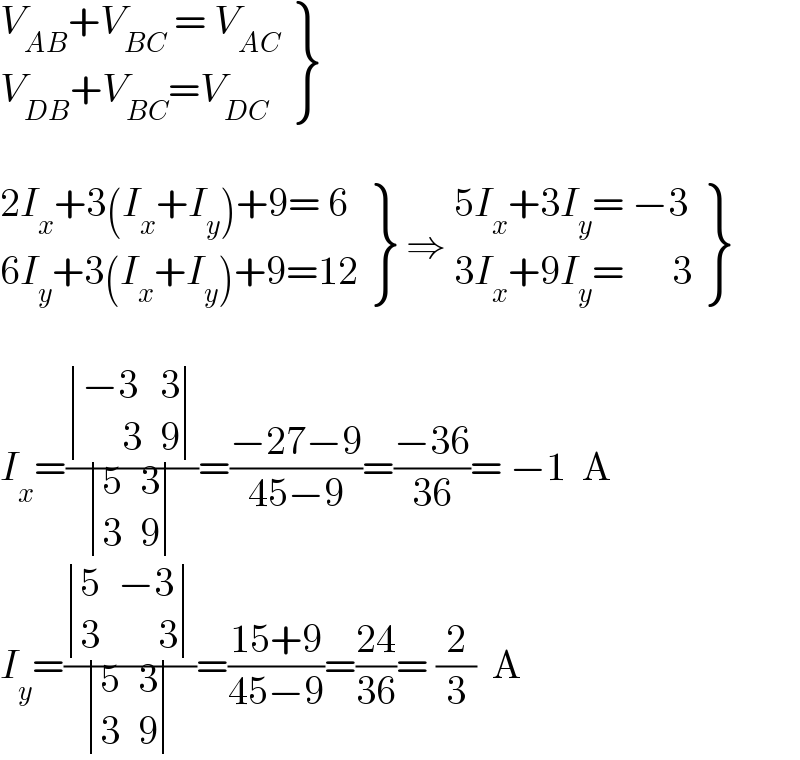
Question Number 148825 by DELETED last updated on 31/Jul/21

Answered by DELETED last updated on 31/Jul/21

$$\Sigma\mathrm{IR}+\Sigma\mathrm{E}=\mathrm{0} \\ $$$$\mathrm{i}_{\mathrm{1}} +\mathrm{i}_{\mathrm{2}} =\mathrm{i}_{\mathrm{3}} \:\rightarrow\mathrm{i}_{\mathrm{2}} \:=\mathrm{i}_{\mathrm{3}} −\mathrm{i}_{\mathrm{2}} \:......\left(\mathrm{1}\right) \\ $$$$\mathrm{2i}_{\mathrm{1}} +\mathrm{3i}_{\mathrm{3}} +\mathrm{9}−\mathrm{6}=\mathrm{0} \\ $$$$\mathrm{2i}_{\mathrm{1}} +\mathrm{3i}_{\mathrm{3}} =−\mathrm{3}\:....\left(\mathrm{2}\right) \\ $$$$ \\ $$$$\mathrm{6i}_{\mathrm{2}} +\mathrm{3i}_{\mathrm{3}} +\mathrm{9}−\mathrm{12}=\mathrm{0} \\ $$$$\mathrm{6i}_{\mathrm{2}} +\mathrm{3i}_{\mathrm{3}} =\mathrm{3}\: \\ $$$$\mathrm{6}\left(\mathrm{i}_{\mathrm{3}} −\mathrm{i}_{\mathrm{1}} \right)+\mathrm{3i}_{\mathrm{3}} =\mathrm{3} \\ $$$$−\mathrm{6i}_{\mathrm{1}} +\mathrm{9i}_{\mathrm{3}} \:=\:\mathrm{3}\:....\left(\mathrm{3}\right) \\ $$$$\left(\mathrm{2}\right)\rightarrow\left(\mathrm{3}\right)\:\:\:\mathrm{2i}_{\mathrm{1}} +\mathrm{3i}_{\mathrm{3}} =−\mathrm{3}\:\:\:\:×\mathrm{3} \\ $$$$\:\:\:\:\:\:\:\:\:\:\:\:\:\:\:\:−\mathrm{6i}_{\mathrm{1}} +\mathrm{9i}_{\mathrm{3}} \:=\:\:\:\:\mathrm{3} \\ $$$$\:\:\:\:\:\:\:\:\:\:\:\:\:\:\:\:−−−−−−−+ \\ $$$$\:\:\:\:\:\:\:\:\:\:\:\:\:\:\:\:\:\:\:\:\:\:\mathrm{6i}_{\mathrm{1}} +\mathrm{9i}_{\mathrm{3}} =−\mathrm{9}\:\: \\ $$$$\:\:\:\:\:\:\:\:\:\:\:\:\:\:\:\:\:\:−\mathrm{6i}_{\mathrm{1}} +\mathrm{9i}_{\mathrm{3}} \:=\:\:\:\mathrm{3} \\ $$$$\:\:\:\:\:\:\:\:\:\:\:\:\:\:\:−−−−−−−+ \\ $$$$\:\:\:\:\:\:\:\:\:\:\:\:\:\:\:\:\:\:\:\:\:\:\:\mathrm{18i}_{\mathrm{3}} \:=\:−\mathrm{6} \\ $$$$\:\:\:\:\:\:\:\:\:\:\:\:\:\:\:\:\:\:\:\:\:\:\:\:\:\:\:\:\mathrm{i}_{\mathrm{3}} \:=\:−\frac{\mathrm{1}}{\mathrm{3}}\:\mathrm{A} \\ $$$$\:\:\:\:\:\:\mathrm{2i}_{\mathrm{1}} +\mathrm{3i}_{\mathrm{3}} =−\mathrm{3} \\ $$$$\:\:\:\:\:\:\mathrm{2i}_{\mathrm{1}} −\mathrm{1}=−\mathrm{3} \\ $$$$\:\:\:\:\:\:\mathrm{2i}_{\mathrm{1}} =−\mathrm{2}\:\rightarrow\mathrm{i}_{\mathrm{1}} =−\mathrm{1}\:\mathrm{A} \\ $$$$\:\:\:\:\:\:\mathrm{i}_{\mathrm{2}} =−\frac{\mathrm{1}}{\mathrm{3}}+\mathrm{1}=\frac{\mathrm{2}}{\mathrm{3}}\:\mathrm{A} \\ $$$$\:\:\:\:\:\:\:\:\:\:\:\:\: \\ $$$$ \\ $$$$ \\ $$$$ \\ $$
Answered by JDamian last updated on 31/Jul/21

$$\left.\begin{matrix}{{V}_{{AB}} +{V}_{{BC}} \:=\:{V}_{{AC}} }\\{{V}_{{DB}} +{V}_{{BC}} ={V}_{{DC}} }\end{matrix}\right\} \\ $$$$ \\ $$$$\left.\begin{matrix}{\mathrm{2}{I}_{{x}} +\mathrm{3}\left({I}_{{x}} +{I}_{{y}} \right)+\mathrm{9}=\:\mathrm{6}}\\{\mathrm{6}{I}_{{y}} +\mathrm{3}\left({I}_{{x}} +{I}_{{y}} \right)+\mathrm{9}=\mathrm{12}}\end{matrix}\right\}\:\Rightarrow\:\left.\begin{matrix}{\mathrm{5}{I}_{{x}} +\mathrm{3}{I}_{{y}} =\:−\mathrm{3}}\\{\mathrm{3}{I}_{{x}} +\mathrm{9}{I}_{{y}} =\:\:\:\:\:\:\mathrm{3}}\end{matrix}\right\} \\ $$$$ \\ $$$${I}_{{x}} =\frac{\begin{vmatrix}{−\mathrm{3}}&{\mathrm{3}}\\{\:\:\:\:\:\mathrm{3}}&{\mathrm{9}}\end{vmatrix}}{\begin{vmatrix}{\mathrm{5}}&{\mathrm{3}}\\{\mathrm{3}}&{\mathrm{9}}\end{vmatrix}}=\frac{−\mathrm{27}−\mathrm{9}}{\mathrm{45}−\mathrm{9}}=\frac{−\mathrm{36}}{\mathrm{36}}=\:−\mathrm{1}\:\:\mathrm{A} \\ $$$${I}_{{y}} =\frac{\begin{vmatrix}{\mathrm{5}}&{−\mathrm{3}}\\{\mathrm{3}}&{\:\:\:\:\:\mathrm{3}}\end{vmatrix}}{\begin{vmatrix}{\mathrm{5}}&{\mathrm{3}}\\{\mathrm{3}}&{\mathrm{9}}\end{vmatrix}}=\frac{\mathrm{15}+\mathrm{9}}{\mathrm{45}−\mathrm{9}}=\frac{\mathrm{24}}{\mathrm{36}}=\:\frac{\mathrm{2}}{\mathrm{3}}\:\:\mathrm{A} \\ $$
